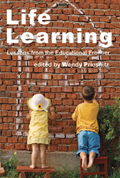|
We are pleased to offer you free PDF downloads of these eBooks
 |
Beyond School: Living As If School Doesn't Exist by Wendy Priesnitz - This is a long-awaited fourth book about life learning (also known as unschooling, radical unschooling, whole life unschooling, or self-education) by unschooling pioneer Wendy Priesnitz. Beyond School is a collection of seventeen essays about how families and individuals can live and learn without coercion or struggles, and with trust, respect, dignity...as if school doesn't exist. Together, they create an impassioned but well reasoned case for a different way of helping children and young people learn about today's world while becoming equipped to live in tomorrow's. PDF digital format only. Go here for more information and a limited time free download.
|
 |
Natural Life Magazine's Green & Healthy Homes by Wendy Priesnitz - The first in the Natural Life Magazine Green Living Series, this book will help you and your family make your home greener and healthier, and save money too. Includes tips on making your own cleaning supplies, advice about energy retrofits, how to avoid and clean up mold, sorting out the plastic controversy, conserving water, avoiding dangerous household chemicals, using organic cotton and hemp textiles for your home, doing a green home reno, understanding threats like electromagnetic radiation and radon, and much more. PDF digital format only. Go here for more information and a limited time free download.
|
 |
Life Learning: Lessons from the Educational Frontier edited by Wendy Priesnitz - A unique collection of 30 essays about the philosophy and the experience of living the unschoolng lifestyle. A great introduction to this progressive style of education, written by parents and young people who have experienced it first hand. Includes learning to read and do math without being taught, the importance of unstructured play, learning when you’re ready, what’s wrong with curriculum, trusting children to do their best naturally, a grandparent’s reaction to unstructured homeschooling, learning in the real world, parents as role models, self-reliance in life and learning, and much more. PDF digital format only. Go here for more information and a limited time free download.
|
 |
Challenging Assumptions in Education: From Institutionalized Education to a Learning Society by Wendy Priesnitz - Why our assumptions about children and how they learn aren't preparing them for life in the 21st Century. And what parents and policy makers can do to change the situation for the better. This controversial book explains why unschoolers (also known as life learners) help their children live and learn without schooling, and provides inspiration and support for families who have chosen that exciting path. It also challenges progressive-minded non-unschooling readers – including teachers, parents, and legislators – to revolutionize the public education system, using what homeschoolers know about how children learn. PDF digital format only. Go here for more information and a limited time free download. |
|
|
|

Natural Life Books specializes in adult non-fiction about ways that families and individuals can live and learn on Planet Earth in a healthy, socially responsible, environmentally sound, self-reliant manner. We are the retail division of The Alternate Press, an imprint of Life Media, an independent, family-owned book and magazine publishing house established in 1976.
|

